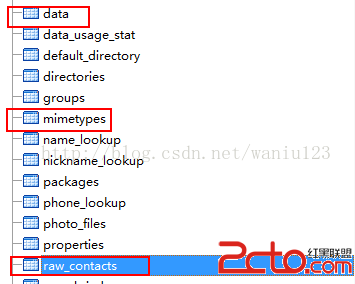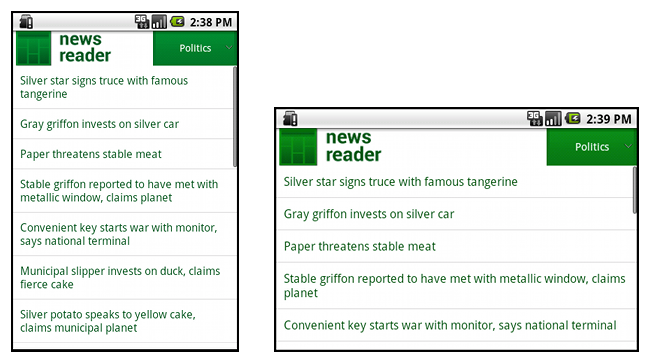在做android藍牙串口連接的時候一般會使用
BluetoothSocket tmp = null;
// Get a BluetoothSocket for a connection with the
// given BluetoothDevice
try {
tmp = device.createRfcommSocketToServiceRecord(MY_UUID);
} catch (IOException e) {
Log.e(TAG, "create() failed", e);
}
然後是tmp。connect方法
可是 BluetoothSocket 。connect方法本身就會報很多錯誤
這是我自己修改的方法
private class ConnectThread extends Thread {
private BluetoothSocket mmSocket;
private BluetoothDevice mmDevice;
ImprovedBluetoothDevice improvedBluetoothDevice;
public ConnectThread(BluetoothDevice device) {
mmDevice = device;
BluetoothSocket tmp = null;
improvedBluetoothDevice = new ImprovedBluetoothDevice(device);
}
public void run() {
Log.i(TAG, "BEGIN mConnectThread");
setName("ConnectThread");
// Always cancel discovery because it will slow down a connection
mAdapter.cancelDiscovery();
String connectionType = "?";
//藍牙設備有三十個端口號,是,從1到30,可以一個一個試,這個辦法雖然笨,可是管用
for(int port = 1; port < 31; port++) {
Log.d(TAG, "Connecting with port: " + port);
try {
connectionType = "Secure";
Log.d(TAG, "Attempting createRfcommSocket");
BluetoothSocket s = improvedBluetoothDevice.createRfcommSocket(port);
s.connect();
mmSocket = s;
} catch (Exception ex) {
Log.e(TAG, ex.toString());
mmSocket = null;
try {
connectionType = "Insecure";
Log.d(TAG, "Attempting createInsecureRfcommSocket");
BluetoothSocket s = improvedBluetoothDevice.createInsecureRfcommSocket(port);
s.connect();
mmSocket = s;
} catch (Exception ex2) {
Log.e(TAG, ex2.toString());
mmSocket = null;
}
}
if (mmSocket != null) {
Log.d(TAG, "Connection succeeded with " + connectionType + " connection on port " + port);
break;
}
}
//如果還沒有獲取到mmSocket ,就使用以下方法
if (mmSocket == null) {
try {
mmSocket = improvedBluetoothDevice.createRfcommSocketToServiceRecord(MY_UUID);
mmSocket.connect();
} catch (IOException e) {
// TODO Auto-generated catch block
e.printStackTrace();
}
}
// Reset the ConnectThread because we're done
synchronized (BluetoothChatService.this) {
mConnectThread = null;
}
// Start the connected thread
connected(mmSocket, mmDevice);
}
public void cancel() {
try {
if(mmSocket!=null)
{
mmSocket.close();
}
} catch (IOException e) {
Log.e(TAG, "close() of connect socket failed", e);
}
}
}
ImprovedBluetoothDevice 這個類
/* Copyright (C) 2011, Kenneth Skovhede
* http://www.hexad.dk,
[email protected]
*
* This library is free software; you can redistribute it and/or
* modify it under the terms of the GNU Lesser General Public
* License as published by the Free Software Foundation; either
* version 2.1 of the License, or (at your option) any later version.
*
* This library is distributed in the hope that it will be useful,
* but WITHOUT ANY WARRANTY; without even the implied warranty of
* MERCHANTABILITY or FITNESS FOR A PARTICULAR PURPOSE. See the GNU
* Lesser General Public License for more details.
*
* You should have received a copy of the GNU Lesser General Public
* License along with this library; if not, write to the Free Software
* Foundation, Inc., 51 Franklin Street, Fifth Floor, Boston, MA 02110-1301 USA
*/
package com.example.bluetoothconnection.util;
import java.io.IOException;
import java.lang.reflect.Constructor;
import java.lang.reflect.InvocationTargetException;
import java.lang.reflect.Method;
import java.util.UUID;
import com.example.bluetoothconnection.R;
import com.example.bluetoothconnection.R.string;
import android.app.AlertDialog;
import android.bluetooth.BluetoothAdapter;
import android.bluetooth.BluetoothClass;
import android.bluetooth.BluetoothDevice;
import android.bluetooth.BluetoothSocket;
import android.content.ActivityNotFoundException;
import android.content.Context;
import android.content.DialogInterface;
import android.content.Intent;
import android.os.Parcel;
import android.os.ParcelUuid;
import android.util.AndroidRuntimeException;
import android.view.View;
import android.view.Window;
import android.view.WindowManager;
//Class that mimics a regular android.bluetooth.BluetoothDevice,
// but exposes some of the internal methods as regular methods
public class ImprovedBluetoothDevice {
public final BluetoothDevice mDevice;
private static Method getMethod(Class<?> cls, String name, Class<?>[] args) {
try {
return cls.getMethod(name, args);
} catch (Exception ex) {
return null;
}
}
private static Constructor<?> getConstructor(Class<?> cls, Class<?>[] args) {
try {
Constructor<?> c = cls.getDeclaredConstructor(args);
if (!c.isAccessible())
c.setAccessible(true);
return c;
} catch (Exception ex) {
return null;
}
}
public static void ActivateBluetooth(Context c, View v) {
try {
//Play nice and use the system dialog for this
c.startActivity(new Intent(BluetoothAdapter.ACTION_REQUEST_ENABLE));
} catch (ActivityNotFoundException ax) {
ManualAskBluetoothActivate(c, v);
} catch (AndroidRuntimeException ax) {
ManualAskBluetoothActivate(c, v);
}
}
private static void ManualAskBluetoothActivate(Context c, View v) {
//If it fails, do this directly
AlertDialog.Builder builder = new AlertDialog.Builder(c);
builder.setCancelable(true);
builder.setMessage(R.string.bluetooth_enable_question);
builder.setTitle(R.string.bluetooth_enable_dialog_title);
builder.setPositiveButton(R.string.yes, new DialogInterface.OnClickListener() {
@Override
public void onClick(DialogInterface dialog, int which) {
BluetoothAdapter.getDefaultAdapter().enable();
}}
);
builder.setNegativeButton(R.string.no, new DialogInterface.OnClickListener() {
@Override
public void onClick(DialogInterface dialog, int which) {
}}
);
//If we are running in the IME, we need to do something special
if (v != null) {
AlertDialog dlg = builder.create();
Window window = dlg.getWindow();
WindowManager.LayoutParams lp = window.getAttributes();
lp.token = v.getWindowToken();
lp.type = WindowManager.LayoutParams.TYPE_APPLICATION_ATTACHED_DIALOG;
window.setAttributes(lp);
window.addFlags(WindowManager.LayoutParams.FLAG_ALT_FOCUSABLE_IM);
dlg.show();
}
else
builder.show();
}
public static void DeactivateBluetooth(Context c) {
AlertDialog.Builder dlg = new AlertDialog.Builder(c);
dlg.setCancelable(true);
dlg.setMessage(R.string.bluetooth_disable_question);
dlg.setTitle(R.string.bluetooth_disable_dialog_title);
dlg.setPositiveButton(R.string.yes, new DialogInterface.OnClickListener() {
@Override
public void onClick(DialogInterface dialog, int which) {
BluetoothAdapter.getDefaultAdapter().disable();
}}
);
dlg.setNegativeButton(R.string.no, new DialogInterface.OnClickListener() {
@Override
public void onClick(DialogInterface dialog, int which) {
}}
);
dlg.show();
}
//private static final int TYPE_RFCOMM = 1;
//private static final int TYPE_SCO = 2;
private static final int TYPE_L2CAP = 3;
private static final Method _createRfcommSocket = getMethod(BluetoothDevice.class, "createRfcommSocket", new Class[] { int.class });
private static final Method _createInsecureRfcommSocket = getMethod(BluetoothDevice.class, "createInsecureRfcommSocket", new Class[] { int.class });
private static final Method _setPin = getMethod(BluetoothDevice.class, "setPin", new Class[] { byte[].class });
private static final Method _setPasskey = getMethod(BluetoothDevice.class, "setPasskey", new Class[] { int.class });
private static final Constructor<?> _socketConstructor = getConstructor(BluetoothSocket.class, new Class[] {int.class, int.class, boolean.class, boolean.class, BluetoothDevice.class, int.class, ParcelUuid.class});
public ImprovedBluetoothDevice(BluetoothDevice base) {
if (base == null)
throw new NullPointerException();
mDevice = base;
}
public BluetoothSocket createRfcommSocketToServiceRecord(UUID uuid) throws IOException {
return mDevice.createRfcommSocketToServiceRecord(uuid);
}
public int describeContents() {
return mDevice.describeContents();
}
public String getAddress() {
return mDevice.getAddress();
}
public BluetoothClass getBluetoothClass() {
return mDevice.getBluetoothClass();
}
public int getBondState() {
return mDevice.getBondState();
}
public String getName() {
return mDevice.getName();
}
public String toString() {
return mDevice.toString();
}
public void writeToParcel(Parcel out, int flags) {
mDevice.writeToParcel(out, flags);
}
public BluetoothSocket createRfcommSocket(int channel) throws Exception {
if (_createRfcommSocket == null)
throw new NoSuchMethodException("createRfcommSocket");
try {
return (BluetoothSocket)_createRfcommSocket.invoke(mDevice, channel);
} catch (InvocationTargetException tex) {
if (tex.getCause() instanceof Exception)
throw (Exception)tex.getCause();
else
throw tex;
}
}
public BluetoothSocket createInsecureRfcommSocket(int channel) throws Exception {
if (_createInsecureRfcommSocket == null)
throw new NoSuchMethodException("createInsecureRfcommSocket");
try {
return (BluetoothSocket)_createInsecureRfcommSocket.invoke(mDevice, channel);
} catch (InvocationTargetException tex) {
if (tex.getCause() instanceof Exception)
throw (Exception)tex.getCause();
else
throw tex;
}
}
public BluetoothSocket createLCAPSocket(int channel) throws Exception {
if (_socketConstructor == null)
throw new NoSuchMethodException("new BluetoothSocket");
try {
return (BluetoothSocket)_socketConstructor.newInstance(TYPE_L2CAP, -1, true, true, mDevice, channel, null);
} catch (InvocationTargetException tex) {
if (tex.getCause() instanceof Exception)
throw (Exception)tex.getCause();
else
throw tex;
}
}
public BluetoothSocket createInsecureLCAPSocket(int channel) throws Exception {
if (_socketConstructor == null)
throw new NoSuchMethodException("new BluetoothSocket");
try {
return (BluetoothSocket)_socketConstructor.newInstance(TYPE_L2CAP, -1, false, false, mDevice, channel, null);
} catch (InvocationTargetException tex) {
if (tex.getCause() instanceof Exception)
throw (Exception)tex.getCause();
else
throw tex;
}
}
public boolean setPin(byte[] pin) throws Exception {
if (_setPin == null)
throw new NoSuchMethodException("setPin");
try {
return (Boolean)_setPin.invoke(mDevice, pin);
} catch (InvocationTargetException tex) {
if (tex.getCause() instanceof Exception)
throw (Exception)tex.getCause();
else
throw tex;
}
}
public boolean setPasskey(int passkey) throws Exception {
if (_setPasskey == null)www.2cto.com
throw new NoSuchMethodException("setPasskey");
try {
return (Boolean)_setPasskey.invoke(mDevice, passkey);
} catch (InvocationTargetException tex) {
if (tex.getCause() instanceof Exception)
throw (Exception)tex.getCause();
else
throw tex;
}
}
}
 Android通訊錄管理一之聯系人獲取
Android通訊錄管理一之聯系人獲取
 android NFC開發案例+MifareClassic格式密碼修改(鍵值keyA修改)
android NFC開發案例+MifareClassic格式密碼修改(鍵值keyA修改)
 Android官方開發文檔Training系列課程中文版:多樣屏幕之支持不同的屏幕尺寸
Android官方開發文檔Training系列課程中文版:多樣屏幕之支持不同的屏幕尺寸
 開源項目ExpandableTextView使用和源碼分析
開源項目ExpandableTextView使用和源碼分析